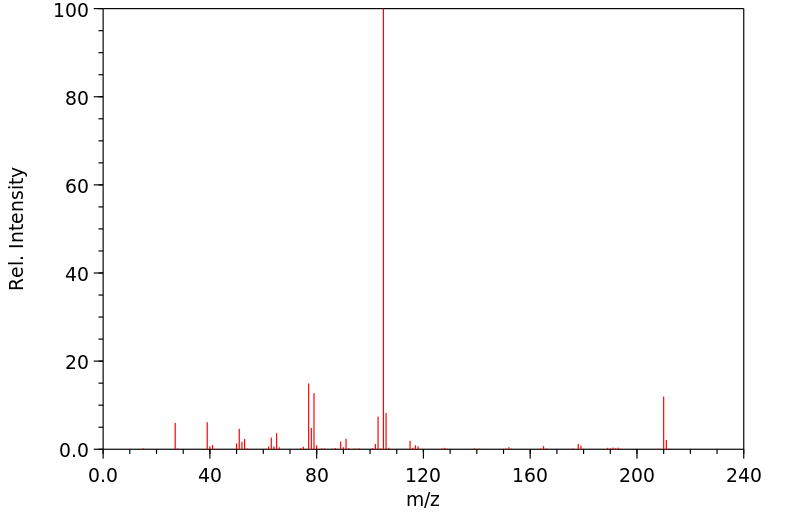1,2-二对甲苯基乙烷 | 538-39-6
中文名称
1,2-二对甲苯基乙烷
中文别名
1,2-二(对甲苯)乙烷
英文名称
1,2-di-p-tolylethane
英文别名
1,2-bis(4-methylphenyl)ethane;4,4'-dimethylbibenzyl;4,4’-dimethylbibenzyl;1-methyl-4-[2-(4-methylphenyl)ethyl]benzene
CAS
538-39-6
化学式
C16H18
mdl
MFCD00026025
分子量
210.319
InChiKey
XCCQFUHBIRHLQT-UHFFFAOYSA-N
BEILSTEIN
——
EINECS
——
-
物化性质
-
计算性质
-
ADMET
-
安全信息
-
SDS
-
制备方法与用途
-
上下游信息
-
文献信息
-
表征谱图
-
同类化合物
-
相关功能分类
-
相关结构分类
物化性质
-
熔点:80-83 °C(lit.)
-
沸点:178 °C(lit.)
-
密度:0.9761 (estimate)
-
闪点:296-298°C/730mm
-
溶解度:可溶于酒精
计算性质
-
辛醇/水分配系数(LogP):4.9
-
重原子数:16
-
可旋转键数:3
-
环数:2.0
-
sp3杂化的碳原子比例:0.25
-
拓扑面积:0
-
氢给体数:0
-
氢受体数:0
安全信息
-
危险品标志:Xn
-
安全说明:S22,S36/37
-
危险类别码:R22
-
海关编码:2902909090
-
储存条件:室温
SDS
上下游信息
-
上游原料
中文名称 英文名称 CAS号 化学式 分子量 对二甲苯二聚体 [2.2]Paracyclophan 1633-22-3 C16H16 208.303 1,2-二苯乙烷 1,1'-(1,2-ethanediyl)bisbenzene 103-29-7 C14H14 182.265 —— {4-[2-(4-hydroxymethyl-phenyl)ethyl]phenyl}methanol 88579-94-6 C16H18O2 242.318 —— 1,2-bis<4-(chloromethyl)phenyl>ethane 38058-86-5 C16H16Cl2 279.209 对甲基苯乙腈 (4-methylphenyl)acetonitrile 2947-61-7 C9H9N 131.177 -
下游产品
中文名称 英文名称 CAS号 化学式 分子量 1-甲基-4-(2-苯基乙基)-苯 4-methylbibenzyl 14310-20-4 C15H16 196.292 [4-[2-(4-甲基苯基)乙基]苯基]甲醇 1-(4-(hydroxymethyl)phenyl)-2-(4-methylphenyl)ethane 89165-05-9 C16H18O 226.318 —— (4-phenethylphenyl)methanol 34224-29-8 C15H16O 212.291 —— 1,2-Bis-(4-trimethylsilylmethyl-phenyl)-aethan 18816-94-9 C22H34Si2 354.683 1-苯基-2-(4-甲基苯基)乙醇 1-phenyl-2-(p-tolyl)ethanol 20498-68-4 C15H16O 212.291 1-(4-甲基苯基)-2-苯基乙醇 1-(4-methylphenyl)-2-phenylethanol 20498-63-9 C15H16O 212.291 —— 1,2-di-4-methylphenylethanol 54881-85-5 C16H18O 226.318 —— 1,2-di-p-tolyl-ethanone 51490-06-3 C16H16O 224.302
反应信息
-
作为反应物:描述:1,2-二对甲苯基乙烷 在 Cs/Na/K alloy 作用下, 以 四氢呋喃 为溶剂, 反应 2.0h, 以225 mg的产率得到1-(2,5-dihydro-4-methylphenyl)-2-p-tolylethane参考文献:名称:Carbanions. 23. Cleavages of 1,2-diphenylethane and derivatives by cesium-potassium-sodium alloy. Competitive rates of bond scission摘要:DOI:10.1021/ja00358a018
-
作为产物:描述:参考文献:名称:脱氧/还原芳族酯,α二酮类,偶姻类,和环氧化物的,以相应的联苄产物与锂4,4'-二吨-butylbiphenyl阴离子自由基摘要:芳族酯,苯偶酰,苯偶姻,超声处理顺和-反式-芪,和反式与在催化量的4,4'-二-的存在过量的锂芪氧化物吨-butylbiphenyl(DBB)在无水THF,得到联苄的衍生物高产。DOI:10.1016/s0040-4039(01)80546-3
文献信息
-
Etude du Comportement Photochimique de quelques Diaryl-1,3-triazènes
-
“Bulky-Yet-Flexible” α-Diimine Palladium-Catalyzed Reductive Heck Cross-Coupling: Highly Anti-Markovnikov-Selective Hydroarylation of Alkene in Air作者:Xu-Wen Yang、Dong-Hui Li、A-Xiang Song、Feng-Shou LiuDOI:10.1021/acs.joc.0c01509日期:2020.9.18regioselective and efficient reductive Heck reaction, a series of moisture- and air-stable α-diimine palladium precatalysts were rationally designed, readily synthesized, and fully characterized. The relationship between the structures of the palladium complexes and the catalytic properties was investigated. It was revealed that the“bulky-yet-flexible”palladium complexes allowed highly anti-Markovnikov-selective
-
Synthesis of Dibenzyls by Nickel-Catalyzed Homocoupling of Benzyl Alcohols作者:Xing-Zhong Shu、Feng-Feng Pan、Peng Guo、Xiaochuang HuangDOI:10.1055/a-1467-2432日期:2021.9blocks that are widely used in organic synthesis, and they are typically prepared by the homocoupling of halides, organometallics, and ethers. Herein, we report an approach to this class of compounds using alcohols, which are more stable and readily available. The reaction proceeds via nickel-catalyzed and dimethyl oxalate assisted dynamic kinetic homocoupling of benzyl alcohols. Both primary and secondary
-
Flash vacuum pyrolysis over magnesium. Part 1. Pyrolysis of benzylic, other aryl/alkyl and aliphatic halides作者:R. Alan Aitken、Philip K. G. Hodgson、John J. Morrison、Adebayo O. OyewaleDOI:10.1039/b108663d日期:2002.1.23Flash vacuum pyrolysis over a bed of freshly sublimed magnesium on glass wool results in efficient coupling of benzyl halides to give the corresponding bibenzyls. Where an ortho halogen substituent is present further dehalogenation gives some dihydroanthracene and anthracene. Efficient coupling is also observed for halomethylnaphthalenes and halodiphenylmethanes while chlorotriphenylmethane gives 4,4′-bis(diphenylmethyl)biphenyl. By using α,α′-dihalo-o-xylenes, benzocyclobutenes are obtained in good yield, while the isomeric α,α′-dihalo-p-xylenes give a range of high thermal stability polymers by polymerisation of the initially formed p-xylylenes. Other haloalkylbenzenes undergo largely dehydrohalogenation where this is possible, in some cases resulting in cyclisation. Deoxygenation is also observed with haloalkyl phenyl ketones to give phenylalkynes as well as other products. With simple alkyl halides there is efficient elimination of HCl or HBr to give alkenes. For aliphatic dihalides this also occurs to give dienes but there is also cyclisation to give cycloalkanes and dehalogenation with hydrogen atom transfer to give alkenes in some cases. For 5-bromopent-1-ene the products are those expected from a radical pathway but for 6-bromohex-1-ene they are clearly not. For 2,2-dichloropropane and 1,1-dichloropropane elimination of HCl occurs but for 1,1-dichlorobutane, -pentane and -hexane partial hydrolysis followed by elimination of HCl gives E,E-, E,Z- and Z,Z- isomers of the dialk-1-enyl ethers and fully assigned 13C NMR data are presented for these. With 6-chlorohex-1-yne and 7-chlorohept-1-yne there is cyclisation to give methylenecycloalkanes and -cycloalkynes. The behaviour of 1,2-dibromocyclohexane and 1,2-dichlorocyclooctane under these conditions is also examined. Various pieces of evidence are presented that suggest that these processes do not involve generation of free gas-phase radicals but rather surface-adsorbed organometallic species.在玻璃棉上覆盖一层新升华的镁,进行闪式真空热解,能有效促使苄基卤化物耦合生成相应的联苄。当有邻位卤素取代基存在时,进一步脱卤生成部分二氢蒽和蒽。卤甲基萘和二苯基甲烷也能高效耦合,而三苯基氯甲烷则生成4,4′-双(二苯甲基)联苯。用α,α′-二卤代邻二甲苯可以获得较高产率的苯并环丁烯,而异构的α,α′-二卤代对二甲苯,通过形成的对二甲苯的聚合,可以得到一系列高热稳定性的聚合物。其他卤代烃苯大体上会脱卤化氢,某些情况下能产生环化反应。同样可以观察到,苯基卤代烷烃脱去羰基生成苯乙炔以及其他产物。简单的烷基卤化物则高效地脱去HCl或HBr生成烯烃。脂肪族二卤化物也会发生这一反应生成二烯,但不发生环化反应生成环烷烃,或在某些情况下发生氢原子转移的脱卤反应生成烯烃。5-溴戊-1-烯的产物符合自由基途径的预期,但6-溴己-1-烯并不符合。2,2-二氯丙烷和1,1-二氯丙烷能脱去HCl,但1,1-二氯丁烷、戊烷和己烷则能部分水解,随后脱去HCl,生成E,E-, E,Z-和Z,Z-异构体二烷-1-烯基醚,并且得到了这些物质的13C NMR全归属数据。6-氯己-1-炔和7-氯庚-1-炔能发生环化反应生成亚甲基环烷烃和环炔烃。本文还考察了1,2-二溴环己烷和1,2-二氯环辛烷在上述条件下的行为。本文给出了众多种证据,表明这些反应过程不涉及气相自由基的形成,而是表面吸附的金属有机物种。
-
Nickel catalyzed deoxygenative cross-coupling of benzyl alcohols with aryl-bromides作者:Vinoth Kumar Chenniappan、Devin Peck、Ronald RahaimDOI:10.1016/j.tetlet.2020.151729日期:2020.4nickel-catalyzed cross-electrophile coupling of benzyl alcohols with aromatic bromides has been developed. This deoxygenative cross-coupling occurs under mild reaction conditions at ambient temperature affording diarylmethanes, or 1,3-diarylpropenes from benzyl allyl alcohols. The system demonstrated good chemoselectivity tolerating an assortment of reactive functional groups.
表征谱图
-
氢谱1HNMR
-
质谱MS
-
碳谱13CNMR
-
红外IR
-
拉曼Raman
-
峰位数据
-
峰位匹配
-
表征信息
同类化合物
(E,Z)-他莫昔芬N-β-D-葡糖醛酸
(E/Z)-他莫昔芬-d5
(4S,5R)-4,5-二苯基-1,2,3-恶噻唑烷-2,2-二氧化物-3-羧酸叔丁酯
(4S,4''S,5R,5''R)-2,2''-(1-甲基亚乙基)双[4,5-二氢-4,5-二苯基恶唑]
(4R,5S)-4,5-二苯基-1,2,3-恶噻唑烷-2,2-二氧化物-3-羧酸叔丁酯
(4R,4''R,5S,5''S)-2,2''-(1-甲基亚乙基)双[4,5-二氢-4,5-二苯基恶唑]
(1R,2R)-2-(二苯基膦基)-1,2-二苯基乙胺
鼓槌石斛素
黄子囊素
高黄绿酸
顺式白藜芦醇三甲醚
顺式白藜芦醇
顺式己烯雌酚
顺式-白藜芦醇3-O-beta-D-葡糖苷酸
顺式-桑皮苷A
顺式-曲札芪苷
顺式-二苯乙烯
顺式-beta-羟基他莫昔芬
顺式-a-羟基他莫昔芬
顺式-3,4',5-三甲氧基-3'-羟基二苯乙烯
顺式-1-(3-甲基-2-萘基)-2-(2-萘基)乙烯
顺式-1,2-双(三甲基硅氧基)-1,2-双(4-溴苯基)环丙烷
顺式-1,2-二苯基环丁烷
顺-均二苯乙烯硼酸二乙醇胺酯
顺-4-硝基二苯乙烯
顺-1-异丙基-2,3-二苯基氮丙啶
非洲李(PRUNUSAFRICANA)树皮提取物
阿非昔芬
阿里可拉唑
阿那曲唑二聚体
阿托伐他汀环氧四氢呋喃
阿托伐他汀环氧乙烷杂质
阿托伐他汀环(氟苯基)钠盐杂质
阿托伐他汀环(氟苯基)烯丙基酯
阿托伐他汀杂质D
阿托伐他汀杂质94
阿托伐他汀杂质7
阿托伐他汀杂质5
阿托伐他汀内酰胺钠盐杂质
阿托伐他汀中间体M4
阿奈库碘铵
锌(II)(苯甲醛)(四苯基卟啉)
银松素
铜酸盐(5-),[m-[2-[2-[1-[4-[2-[4-[[4-[[4-[2-[4-[4-[2-[2-(羧基-kO)苯基]二氮烯基-kN1]-4,5-二氢-3-甲基-5-(羰基-kO)-1H-吡唑-1-基]-2-硫代苯基]乙烯基]-3-硫代苯基]氨基]-6-(苯基氨基)-1,3,5-三嗪-2-基]氨基]-2-硫代苯基]乙烯基]-3-硫代
铒(III) 离子载体 I
铀,二(二苯基甲酮)四碘-
钾钠2,2'-[(E)-1,2-乙烯二基]二[5-({4-苯胺基-6-[(2-羟基乙基)氨基]-1,3,5-三嗪-2-基}氨基)苯磺酸酯](1:1:1)
钠{4-[氧代(苯基)乙酰基]苯基}甲烷磺酸酯
钠;[2-甲氧基-5-[2-(3,4,5-三甲氧基苯基)乙基]苯基]硫酸盐
钠4-氨基二苯乙烯-2-磺酸酯








